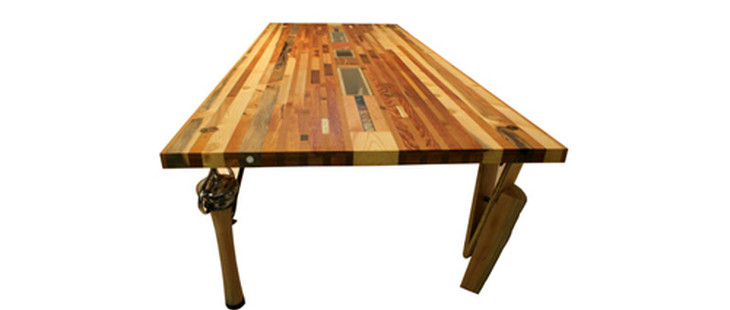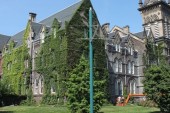
 (YMCA Table)
(YMCA Table)
Lars and Jason Dressler, the brother duo behind furniture and design studio Brothers Dressler, have been saving objects, materials and furniture from the landfill for years by incorporating found objects into their down-to-earth handcrafted designs. The studio is bustling with projects: the pair recently completed a commemorative table for YMCA Canada made entirely out historical Canadian artefacts sent in from YMCA associations across the country (check out a video on the process here), and is working with architect Todd Saunders on a inn on Fogo Island off the coast of Newfoundland. Toronto Standard nabbed a few moments of their time to talk about where they find their salvage materials, the handcraft market and the beauty of wood.
When did you start the studio?
The Brothers Dressler started in May 2003. Jason just graduated from Sheridan’s Craft and Design program and we discussed the idea of pursuing a career in furniture, so I quit my job and we dove in. From the beginning we attempted to develop our own pieces and designs while at the same time doing jobs with other makers, architects and designers. Slowly we were able to work more on our own projects and further develop our own designs. In 2008 we moved shops and started up a co-op in the Junction Triangle area with some other great makers. Since then we have been able to grow more. We turned the space next to the workshop into our lab, which allows us more room to prototype and experiment.
 (Log Seating)
(Log Seating)
You use a lot of salvage materials in your work, like your Log Seating made from stumps salvaged during the 2009 city services strikes when the tree dump was closed, and your School Chairs made from seats from a defunct felt factory. How do you find all the materials?
Sometimes it’s more about how an object has found us. Whether it is the soot and scat-covered conveyor apron in the bottom of an old loft building Jason lived in, or finding a set of piano keys while walking my son to sleep. So often it is a pleasure to come across something that has potential. We acquired a recently-tipped hydro pole that I passed on my way home and helped hydro workers to dispose of, as well as countless obsolete automotive parts collected over the 30-year history of the Ossington Avenue auto shop that became Boehmer.
 (School Chairs)
(School Chairs)
One of your most celebrated series in recent memory is the furniture and accessory items made from shoe lasts—I’m thinking of the Last Bloom vase, the Last Night coat rack and the Last Waltz bench, among others. How did you find those?
Another example of found objects that had found us. Our father was fishing in Northern Ontario and across a pile of the shoe lasts with a sign reading, “Firewood for Cottagers.” He asked if we were interested in them, which we certainly were. It would be such a shame that such finely crafted and engineered pieces would be combusted.
What’s your process like when you come across new found objects you want to work with? How do you experiment with them?
It all depends on the material we come across and the circumstances. Quite often it or a sample has to be cleaned up to see what it really looks like, although we immediately start thinking about its uses or potential for use. We consider jobs or designs that it might work for and if no arise we put it somewhere that it is viewable in the workshop to keep it in mind. When the time is there, though, we start manipulating and sculpting it with wood and other objects to see how it can be used. This is one of the best parts of our jobs.
 (Last Place Seating)
(Last Place Seating)
Your studio is a big part of Canada’s handcraft market. How has this market changed over the past decade?
Numerous ways. More and more people are able to pursue their passion as an outlet for creativity, and sustain themselves in this sometimes-not-so-sustainable world. This is aided by the people who help support the handcraft market by purchasing these goods; they have made a decision to think about where their possessions come from, how they are made, what they are made from and who makes them. The handcraft market is no longer just folk art or precious materials, [but rather] it coincides with the movement towards local living. It spans a vast array of objects that fit countless needs.
Which designers inspire you in your work?
French metal worker/architect Jean Prouv, the Campana brothers, Toronto design studio Castor, Patty Johnson, woodworker George Nakashima, Dutch designer Piet Hein Eek, Droog cofounder Renny Renmakers and Italian architect Carlo Mollino, among others. There are countless people in the community and in the past that all have done amazing things.
 (Onedge Rocker)
(Onedge Rocker)
How does sustainability inform your work?
Sustainability certainly dictates much of our designs, including material choice and process. The materials dictate the look of a piece, whether it is responsibly-sourced wood used in its entirety with live edge, knots, and other blemishes that enhance the look and feel, or a found object that still retains much of the patina of years of use and abuse. We think about process with regards to efficiency or immediacy, keeping in mind the lifecycle of the piece. This sometimes results in exposed hardware, ease of disassembly or wooden joinery, all of which certainly affect the aesthetic.
You work a lot, nearly exclusively, with wood—what it is about the material?
Wood is such a supple, natural material that is easily manipulated and joined together. It is renewable and locally available in abundance. It can be reused and made into other objects throughout its life after death. But its beauty is what attracts us most, both before it is made into lumber and more importantly after it has been altered. There is a life to wood that remains even after the tree has been felled. It is hard to find in other materials.
What do you have on the go right now?
We are busy working on future ideas but also taking time just to keep up with current projects. We continually hone our made-to-order catalogue while taking on custom works, such as dining tables and bedroom suites. We’ve had some interest from Sweden and Vancouver, as well as some talks for a new restaurant in Toronto.
 (Walking Table)
(Walking Table)
What can we expect from Brothers Dressler at Toronto Design Week this January?
We’ll be displaying our front foyer lighting for the Public Displays of Affection project at 40 Oaks in Regent Park. They will be created out of old discarded lighting from the former church that was there combined with elements made from the old church pews. Also, we’re working on a new dining table design, some new lighting, and a few surprises which we hope to have ready.
What’s it like working together as brothers – twins, no less!
It’s great working with one’s twin whom you share as similar-as-possible DNA. This means that we have a similar base approach and aesthetic but through the different experiences we have accumulated we bring in unique aspects to our designs. On the technical side we both have varying skills that complement each other in many ways.
We can also get mad at each other and don’t worry about ruining a friendship, as we have no choice.
__
Paige Magarrey writes on design for Toronto Standard.














